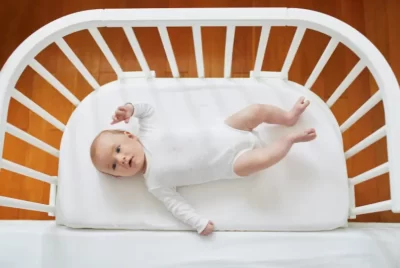When do you stop swaddling a baby?
We may earn a small commission for purchases made using our links (not affecting your price).
See our disclosure to learn more.
It’s a wise move to swaddle your newborn to promote deeper sleep. Wrapping your baby in a snug wrap can help him feel safe and secure as he adjusts to life outside the womb, keep him warm and comfortable when his internal thermostat kicks in, and prevent him from flailing his arms and legs and inciting the startle reflex. You may have heard that during the first few months following birth, newborns yearn to be in the womb.
When do you stop swaddling a baby?
They enjoy the sense of security that comes with feeling comfortable while they sleep, and swaddling provides just that. Still, it’s not possible to swaddle babies forever. Now, you should know when you stop swaddling a baby. But it will be time to bid the practice farewell in a few short months. When your baby gets older and more mobile, swaddling can become risky even though it’s safe for newborns.
What Does Swaddling Mean?

The ancient practice of swaddling a baby to promote sleep has been around for a while. Ninety percent of babies in North America are said to be swaddled during their first few months of life; the practice has grown in popularity in recent years.
However, because improper swaddling can result in suffocation or hip issues, safety concerns surround this practice. Your newborn will sleep sounder and in the ideal posture—on their back—if you swaddle them. It is the recommended sleeping position by doctors for infants to reduce SIDS (sudden infant death syndrome). Your baby will eventually outgrow the swaddle. What you should know is as follows.
Is it safe to swaddle your newbies?
Correct swaddling techniques can make it safe for your newbies. It can promote better sleep in infants and may be especially beneficial for infants born with colic, brain disorders, or alcoholism. It’s crucial to keep in mind that while swaddling a baby is not required, loose blankets should be avoided when doing so.
Also, a sleep sack that allows the baby’s legs to move should be used instead of a fitted blanket if the baby will be swaddled for extended periods during the day or night. Your newborn will sleep better and be calmer if you swaddle them.
How Do Swaddling Clothes Work?
How to swaddle a baby? Most baby stores carry swaddling clothes for purchase. Different kinds of swaddling clothes exist. Simple square or rectangular blankets make up a few of them. Some resemble baby sleep sacks and let you zip your infant inside. Some have extra flaps on the side that are fastened with sticky strips and wrap around your baby’s body.
How can one get out of the swaddle?
1. Adopting a blunt approach: Place your infant in a sleep sack, leaving your arms free.
2. Arm extended in swaddling: As you have been doing, swaddle cozy but expose one arm. Your baby will be able to adjust gradually as a result. After your baby is adjusting well to having one arm free, continue doing this for one to two weeks before switching to a sleep sack with both arms free. Regarding the precise timing, take your baby’s lead.
3. A half-night: When babies take off their swaddles too soon, it can seriously disturb their sleep. Sometimes, though, parents just have a gut feeling that it’s time to start easing their child out of the swaddle. If this describes you AND your child isn’t rolling over, the “partial night” option might be your best bet.
When you use this technique, you’ll start the night with one or both arms out of the swaddle. Once your baby wakes up, put both arms back into the swaddle and rock them again. Switch to a sleep sack once your baby can fall asleep with both arms out of their crib OR begins to roll over.
Introduce a transitional piece
The Swaddle Sleeves are one amazing piece of transitional clothing. The baby can still move around and settle into a comfortable position on their back or belly thanks to the sleeves, which also help to reduce the startle reflex in the arms. A few parents adore Merlin’s Magic Sleep Suit as well.
This three-layered suit helps to stifle twitches and startle movements that could wake babies up too soon, allowing them to stay on their backs for longer periods and giving them the comfort they need. If your child was sleeping soundly before the swaddle transition, you might require a transitional item. However, if you had trouble sleeping before stepping out of the swaddle, a transitional item won’t make all the difference.
When to Put Your Infant in a Swaddle
Most of the time, you will swaddle your baby to help them fall asleep and to soothe them when they are fussy. It’s crucial to cease swaddling your infant as soon as they attempt to roll over. You can use sleep sacks or wearable blankets and security blankets on your baby until they are about two or thirty pounds or until they no longer compress their arms and chest. Your baby should be able to use a blanket once they outgrow their sleeping bag.
How to Wrap Your Infant in a Swaddle

Grasp the left corner of the blanket with one hand while holding your infant.
- Lay the blanket over your infant’s body.
- Place the blanket between their body and right arm.
- It should pass through their bottom and lower back.
- Press your baby’s left arm gently against their side and straighten it. Take up the blanket’s right corner and drape it over their entire body. Place it beneath their left side.
- The blanket should be folded or loosely twisted before being tucked under your child.
- Only your baby’s head and neck should be visible through the swaddle.
- Avoid swaddling your baby so tightly that they are unable to bend their legs.
- Grasp the left corner of the blanket with one hand while holding your infant.
- Usually, that works out to be two or four months.
- During this time, when your baby can be able to roll onto their stomach, but it may not be rolled back over.
- It may increase their chance of SIDS.
Symptoms: It’s Time to Give Up Swaddling
You know it’s time to stop swaddling your baby when they try to get over it. It is unsafe to continue swaddling after this point. It could occur as soon as two months or a little later.
If you notice any of the following indicators that your baby might be overheating, it’s also time to stop swaddling:
- Sweating Wet hair
- rosy cheeks
- Heat rash: Breathing too quickly.
Benefits and Drawbacks of Swaddling
A baby may sleep better when swaddled, but there are drawbacks as well. There are several benefits to swaddling your infant.
Improved slumber: Swaddled babies feel as though they are once again inside the womb. Some parents report that their infant has less of a startle reflex and can sleep deeper. Swaddling prolongs a baby’s sleep and reduces the number of times it wakes up on its own, according to a small study involving 16 babies between the ages of 10 and 16 weeks. However, more research is required.
Reduce the crying: Research indicates that swaddling can reduce a baby’s crying when combined with movement and sound.
Drawbacks:
Higher chance of SIDS: The United States experiences roughly 3,500 baby sleep-related deaths annually. One of the biggest risk factors for SIDS—the unexpected and unexplained death of a baby under the age of one—is thought to be sleeping with a baby on their stomach. This risk is further increased by swaddling. According to some researchers, low arousal during sleep makes it more difficult for an infant to wake up, which may be the cause of SIDS. A baby’s arousal level may be lowered by swaddling.
Loose bedding: An improperly wrapped baby can wriggle out of the swaddle. The loose swaddling cloth in the crib may obstruct your baby’s airway. SIDS risk is increased by loose bedding.
Becoming too hot: You want to make sure your baby stays cool because the swaddle adds an extra layer of protection. Check if they feel warm or sweaty by touching the back of the neck or chest. Take off an extra layer of clothing or use a swaddle made of cotton or muslin, which is lighter and more breathable.
Hip dysplasia in development: Hip dysplasia risk can be raised by improper swaddling. It is an issue with the formation of the hip joint.
The Dangers of Swaddling
Experts caution that swaddling also has some risks, especially if it makes your baby’s arousal from sleep. A baby’s risk of sudden infant death syndrome (SIDS) may rise if they are unable to wake up on their own. If you are unsure about the safety of swaddling your baby or have concerns, speak with their healthcare provider.
The Final Word
Although swaddling can help your newborn fall asleep more soundly, once your baby begins to roll over on her own, it is advised to stop. Additionally, it’s best to stop swaddling, switch to a lighter swaddling blanket, or turn down the temperature in the room if you notice your baby getting too hot.
Remember that swaddling your infant is not a requirement. You can learn how to swaddle your baby from your healthcare provider as well safely. One technique that parents have to help their infant sleep through the early months is swaddling.
To find what works best for your newborn, you can also experiment with things like establishing a relaxing sleep schedule and turning on calming music.




